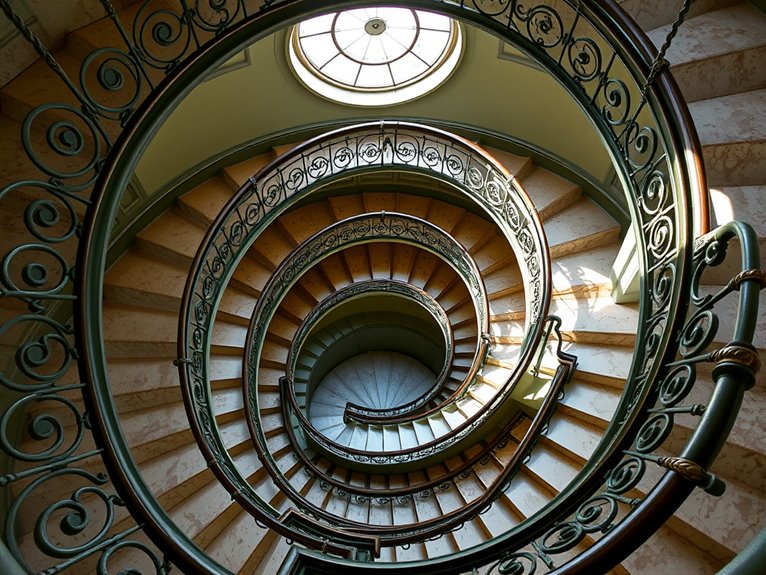
7 Unique Parisian Staircases Worth Photographing
Paris's most photogenic staircases will take your breath away! I've discovered seven architectural marvels you won't want to miss: the revolutionary spiral at Hôtel Tassel, Square Rapp's mesmerizing Art Nouveau design, Le Bon Marché's geometric double helix, Galerie Vivienne's hidden treasures, Château De Chambord's da Vinci-inspired masterpiece, Ry's floating helix, and Palais Garnier's golden showstopper. Each staircase tells its own unique story, from hidden salamander motifs to stunning natural light effects. Let's explore these remarkable landmarks together and uncover their secrets!
The Spiral Elegance of Hôtel Tassel

Victor Horta's masterpiece, the Hôtel Tassel, stands as one of the most significant examples of Art Nouveau architecture in Paris, with its revolutionary spiral staircase serving as the building's crown jewel. Built in 1893, this architectural marvel transformed the way designers approached interior spaces, introducing organic, flowing forms that would define an entire movement.
The staircase's hypnotic spiral, crafted from iron and wood, creates an almost otherworldly experience as natural light filters through the stained-glass skylight above, casting ever-changing patterns on the intricate whiplash curves below. This remarkable fusion of form and function demonstrates how a utilitarian element can become a transcendent piece of art, making it a must-see destination for architecture enthusiasts and photographers alike.
Quick Facts:
- Visiting Hours: Tuesday-Sunday, 10:00 AM – 4:00 PM
- Photography: Permitted without flash; tripods require advance permission
- Price: €15 for general admission; €12 for students
- Best Time: Early morning for optimal natural light
- Guided Tours: Available in English, French, and German
- Accessibility: Limited due to historical preservation status
The Staircase Design:
The spiral staircase rises through three levels, featuring hand-forged iron railings that seem to grow organically like vines. The strategic placement of mirrors and windows creates an illusion of endless space, while the innovative use of industrial materials alongside natural motifs showcases Horta's genius for blending the mechanical with the organic. Insider tip: Look for the hidden signature of Horta himself, discretely carved into the bottom newel post.
The Light Play:
The staircase's most magical feature is its interaction with light throughout the day. The carefully positioned stained-glass windows and skylight create different color patterns as the sun moves across the sky. The best photographs can be captured between 11 AM and 1 PM when the light hits the metalwork at prime angles, creating dramatic shadows and highlighting the golden patina of the brass details.
Pro Tips:
To truly appreciate the staircase's architectural complexity, visit during different times of day. Morning light emphasizes the metalwork's detail, while afternoon sun creates dramatic shadows that transform the space. Consider booking a specialized architecture tour that includes access to normally restricted viewing angles, allowing for unique photographic opportunities and deeper insight into the construction techniques.
Practical Advice:
Reserve tickets online at least two days in advance, especially during peak tourist season (June-August). Wear comfortable, non-slip shoes as the historic steps can be slick, and bring a wide-angle lens if you're planning to photograph the space. Note that the building is still partially used for private functions, so certain areas may be restricted on specific days – check the website for current access information before visiting.
Art Nouveau Dreams at Square Rapp
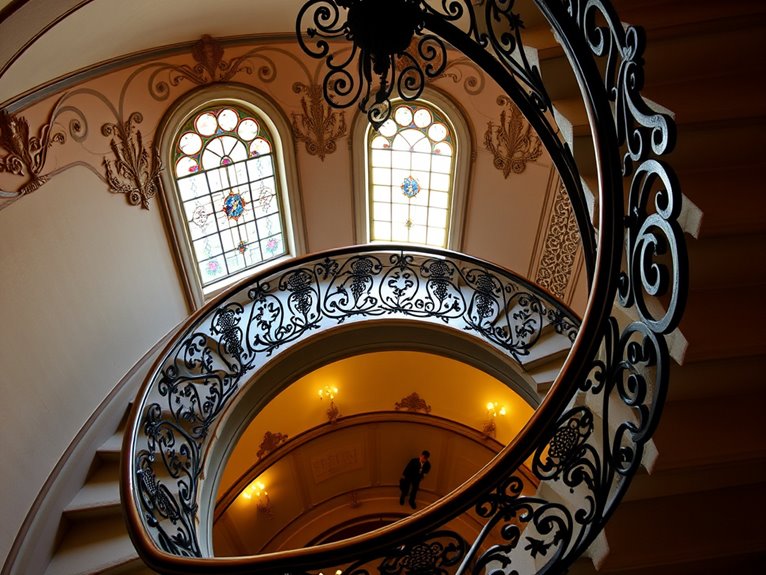
Hidden in the elegant 7th arrondissement, Square Rapp stands as one of Paris's most exquisite examples of Art Nouveau architecture, centered around a mesmerizing spiral staircase that seems to dance through space. This architectural masterpiece, created during the height of the Art Nouveau movement in the early 1900s, captivates visitors with its organic forms, intricate ironwork, and harmonious blend of natural motifs.
The square's crown jewel, located at number 3, showcases architect Jules Lavirotte's vision of fluid, nature-inspired design that epitomizes the Art Nouveau style. The building's staircase, visible through an ornate entrance gate, has become a pilgrimage site for architecture enthusiasts and photographers seeking to capture one of Paris's most photogenic architectural elements.
Quick Facts:
- Best visiting hours: 8:00 AM – 6:00 PM (exterior viewing only)
- Photography: Early morning light best for capturing details
- Access: Free to view from street
- Nearest Metro: Alma-Marceau (Line 9)
- Peak tourist times: 11:00 AM – 3:00 PM
- Photography permits: Required for commercial shooting
The Square Rapp Building
The main building features a spectacular façade adorned with sculptural elements including peacocks, flowers, and feminine figures. The spiral staircase, visible through the entrance, demonstrates the perfect marriage of form and function, with wrought iron railings that curve and flow like natural vines. The building remains a private residence, but the exterior and entrance area are accessible for viewing.
Insider tip: Look for the hidden salamander motifs in the ironwork – Lavirotte's signature element appears in unexpected places throughout the design.
The Square Rapp Courtyard
The intimate courtyard offers an unparalleled view of the Eiffel Tower, perfectly framed by the Art Nouveau architecture. While the courtyard is technically private property, respectful photographers can often capture stunning images from the entrance gate. The space comes alive in spring when the surrounding gardens bloom.
Insider tip: Visit during the first week of April when the courtyard's wisteria is in full bloom, creating a purple canopy that complements the architectural elements.
Pro Tips:
The best photographs of the staircase can be captured between 9:00 and 10:00 AM when morning light filters through the entrance gate, creating dramatic shadows across the ironwork. Consider using a wide-angle lens to capture the full spiral effect, and don't forget to look up – some of the most interesting details are overhead.
Practical Advice:
As Square Rapp houses private residences, visitors should maintain a respectful distance and keep noise levels down. Photography is permitted from the street, but tripods may attract attention from security. Consider combining your visit with other Art Nouveau sites in the area, including Avenue Rapp and Rue Jean Carriès, to make the most of your architectural tour of the 7th arrondissement.
Geometric Marvel at Le Bon Marché
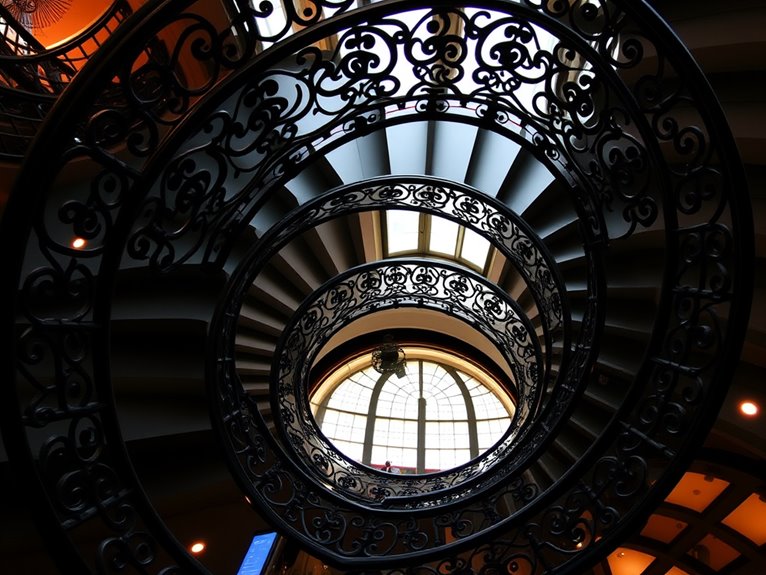
The iconic spiral staircase at Le Bon Marché stands as an emblem to the marriage of architectural innovation and artistic vision in Paris's oldest department store. Designed during the store's 1872 renovation, this double helix masterpiece creates an optical illusion that has captivated visitors for nearly 150 years, transforming a functional element into a celebrated architectural landmark.
Beyond its practical purpose, the staircase represents the golden age of Parisian department stores and the city's commitment to merging commerce with artistic excellence. The intricate geometric patterns, enhanced by natural light streaming through the building's glass roof, create an ever-changing display of shadows and reflections throughout the day, making it a favorite subject for photographers and architecture enthusiasts alike.
Quick Facts:
- Best visiting hours: 10:30 AM – 3:00 PM (optimal lighting)
- Photography: Permitted without flash
- Store hours: 10:00 AM – 8:00 PM (Monday-Saturday)
- Busiest periods: Saturday afternoons and holiday seasons
- Access: Free with store entry
- Best viewing floors: 2nd and 3rd levels
- Photography spots: Central atrium and upper-level balconies
The staircase's unique double helix design allows two separate paths that never intersect, creating an elegant solution to managing customer flow while delivering a visually stunning experience. Located in the store's central atrium at 24 Rue de Sèvres, the structure spans multiple floors and is constructed from wrought iron and brass, materials that reflect the industrial revolution's influence on Parisian architecture. An often-overlooked detail is the original manufacturer's stamp visible on the third-floor landing, dating the metalwork to the early 1870s.
Pro Tips:
The most dramatic photographs can be captured during mid-morning hours when sunlight streams through the glass ceiling, creating dynamic shadows across the spiral forms. Position yourself on the second floor, facing north, to capture the full scope of the geometric patterns. For the best experience without crowds, visit on Tuesday or Thursday mornings, when tourist numbers are typically lower and the store's lighting system has been freshly maintained.
Practical Advice:
While the staircase is open to the public during store hours, some sections may be temporarily closed during holiday decoration installations or maintenance work. It's advisable to check the store's website for any scheduled maintenance before planning a dedicated photography visit. Remember that the store's security staff may request photographers to move if they're blocking customer traffic, so be prepared to be mobile and respectful of shopping activities.
Hidden Treasures of Galerie Vivienne
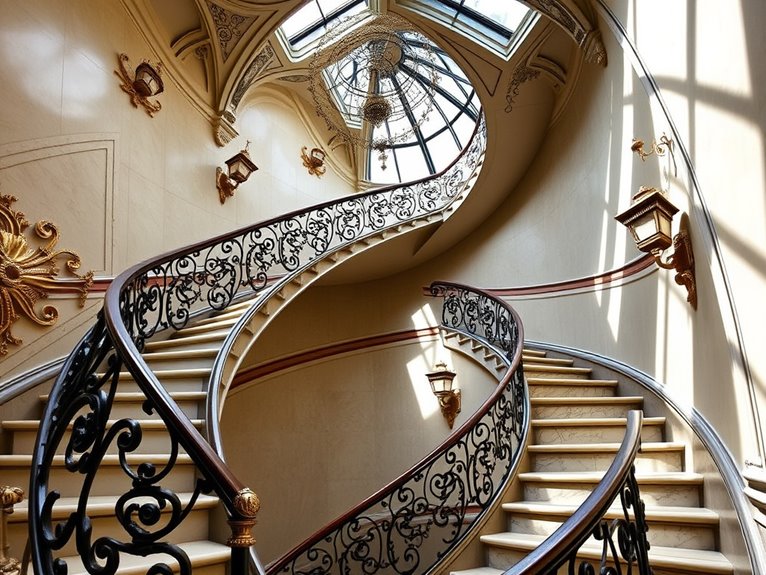
Nestled in Paris's 2nd arrondissement, the Galerie Vivienne stands as one of the city's most elegant covered passages, but it's the remarkable staircases within this 19th-century architectural gem that truly capture visitors' imagination. These hidden spiral staircases, with their intricate ironwork and worn marble steps, tell stories of centuries past while offering glimpses into the private spaces above the gallery's luxurious boutiques.
Beyond their architectural significance, these staircases represent a unique intersection of Parisian history and daily life, having served generations of residents and merchants since 1823. While most visitors focus on the gallery's mosaic floors and glass ceiling, the discrete staircases offer photography enthusiasts and architecture lovers an opportunity to discover authentic pieces of Parisian heritage often overlooked by traditional tourist guides.
Quick Facts:
- Best visiting hours: 8:30 AM – 8:30 PM (Monday to Saturday)
- Photography: Permitted in public areas; tripods prohibited
- Access: Some staircases visible from gallery floor, others require merchant permission
- Lighting: Best natural light between 11 AM – 2 PM
- Cost: Free to explore public areas
- Nearest Metro: Bourse (Line 3) or Palais Royal-Musée du Louvre (Lines 1, 7)
Notable Staircases:
The Libraire Jousseaume Spiral
Located within Paris's oldest bookshop, this cast-iron masterpiece features delicate botanical motifs and offers a rare glimpse into 19th-century craftsmanship. The staircase remains functional, connecting the ground-floor bookshop to its upper-level rare book collection. Insider tip: The bookshop owner occasionally permits photographs of the staircase if you purchase a book.
The Wine Merchant's Stairwell
This limestone staircase, tucked behind an unassuming door near the gallery's northern entrance, features unique wine-themed carvings on its balustrade. While not typically open to the public, the staircase can be viewed through an ornate glass panel. Insider tip: Visit during the annual Heritage Days (Journées du Patrimoine) in September for rare interior access.
The Central Rotunda Staircase
The gallery's most photographed staircase rises through a light-filled rotunda, combining wrought iron with marble steps worn smooth by centuries of use. Access is limited to building residents, but the first few steps and decorative newel post are visible from the gallery floor. Insider tip: Morning light creates stunning shadow patterns through the rotunda's glass ceiling.
Pro Tips:
Photography enthusiasts should visit during early morning hours when the gallery first opens, as the angle of sunlight through the glass ceiling creates dramatic shadows on the staircases. Consider bringing a wide-angle lens to capture the full vertical scope of these architectural elements. For the best results, shoot during overcast days when diffused light reduces harsh contrasts and allows for better detail capture in both the ironwork and stone features.
Practical Advice:
While exploring these architectural treasures, remember that many areas serve as private residential access points. Maintain a respectful distance from entrances, speak quietly, and always ask permission before photographing areas that might intrude on private spaces. Some merchants may allow closer access to certain staircases if approached politely and during less busy hours.
The Double Helix at Château De Chambord
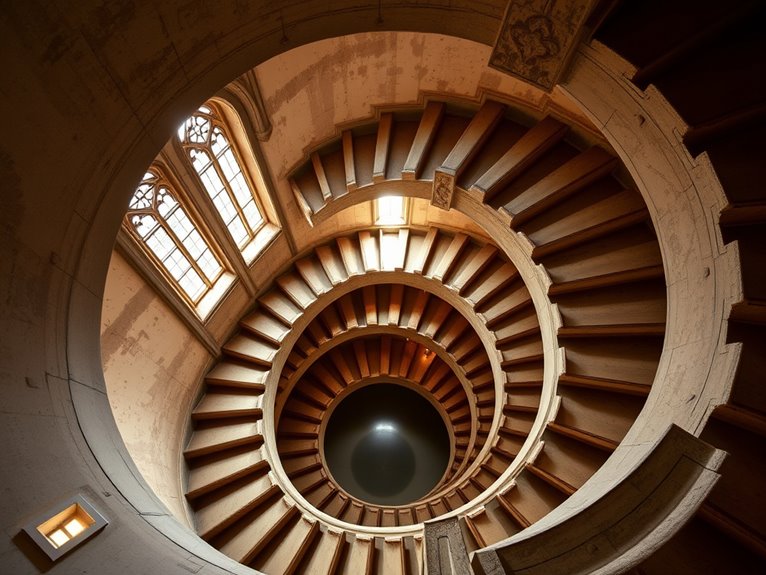
The remarkable double helix staircase at Château de Chambord stands as one of the most innovative architectural features of the French Renaissance period. Attributed to Leonardo da Vinci's genius, this masterpiece consists of two intertwining spiral staircases that wind around a central column, allowing two people to ascend or descend simultaneously without ever meeting. This architectural marvel serves as both a functional element and an artistic statement, embodying the creative spirit of the Renaissance.
Located in the heart of France's Loire Valley, this extraordinary staircase has captivated visitors for centuries with its mathematical precision and aesthetic beauty. The structure rises through three floors of the château, offering breathtaking views of the surrounding architecture while demonstrating the ideal marriage of form and function that characterized Renaissance design principles.
Quick Facts:
- Best visiting hours: 9:00 AM – 5:00 PM (less crowded early morning)
- Entry cost: €14.50 for adults (includes château access)
- Photography: Allowed without flash; tripods require special permission
- Peak seasons: July-August and December
- Accessibility: Limited for mobility-impaired visitors
- Guided tours available: Yes (additional €5)
- Best photo opportunities: Mid-morning when natural light streams through windows
The Double Helix Experience:
The staircase spans 24 meters in height and features two separate spiral staircases that rotate around a hollow central column. The innovative design allows natural light to filter down through the entire structure, creating dramatic shadows and lighting effects throughout the day. Visitors can access the staircase from the ground floor, with each revolution offering unique perspectives of both the interior architecture and the surrounding château grounds through strategically placed windows.
Pro Tips:
For the most memorable experience, visit during the "golden hour" (about an hour before sunset) when the light creates stunning effects through the windows and across the limestone surfaces. Photographers should consider bringing a wide-angle lens to capture the full spiral effect, and visit during shoulder season (April-May or September-October) when crowds are thinner and lighting conditions remain favorable.
Practical Advice:
Reserve at least 30 minutes to fully explore the staircase, taking time to ascend and descend both spirals. Wear comfortable, non-slip shoes as the stone steps can be smooth from centuries of use. Consider joining a guided tour to learn about the mathematical principles behind the design and the historical significance of this architectural masterpiece. Photography enthusiasts should visit on clear days when natural light is optimal for capturing the interplay of light and shadow through the windows.
Industrial Beauty at Bibliothèque Sainte-Geneviève
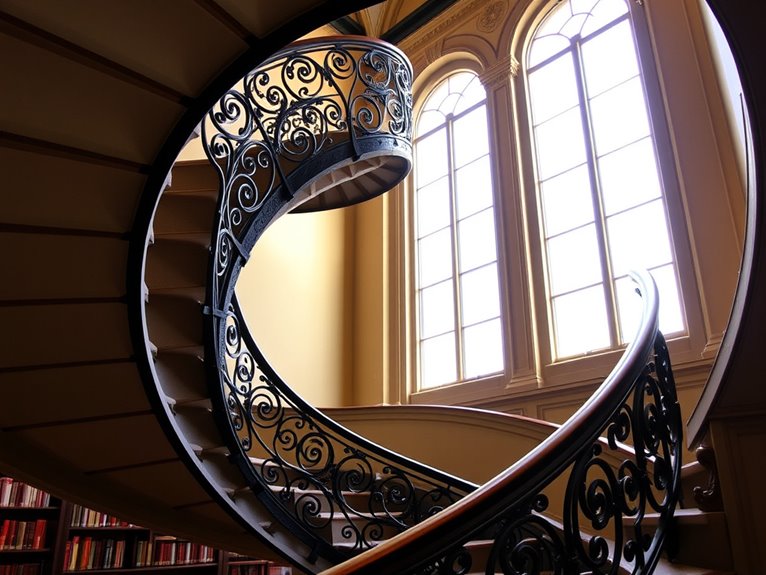
The Bibliothèque Sainte-Geneviève stands as a masterpiece of 19th-century industrial architecture, where its iconic spiral staircase serves as both a functional element and an artistic statement. Designed by Henri Labrouste in 1850, the library's staircase represents a pivotal moment in architectural history, combining cast iron's industrial strength with elegant aesthetic sensibilities.
This remarkable structure has inspired architects and designers for generations, featuring a delicate helix that seems to float within its stone enclosure. The staircase's innovative use of materials and revolutionary design approach marked a departure from traditional stone staircases, showcasing how industrial materials could create spaces of extraordinary beauty.
Quick Facts:
- Opening Hours: Monday-Saturday, 10:00-22:00
- Photography: Permitted without flash
- Access: Free with library membership card
- Best Viewing Times: 14:00-16:00 (optimal natural light)
- Crowd Levels: Lowest during morning hours
- Photography Permits: Required for professional shoots
The Spiral Masterpiece
The main spiral staircase rises through three floors, constructed entirely of cast iron with intricate filigree patterns that create a lace-like appearance. Located in the library's west wing, the staircase features 87 steps with original wrought iron railings that showcase period-specific decorative motifs. The restoration completed in 2015 preserved the original metalwork while reinforcing structural elements.
Architectural Innovation
Labrouste's design revolutionized library architecture by exposing the building's structural elements rather than concealing them. The staircase's open design allows natural light to filter through, creating constantly changing shadow patterns throughout the day. The integration of industrial materials with classical proportions demonstrates the perfect marriage of function and form.
Pro Tips:
Visit during winter months when sunlight streams through the western windows at a lower angle, creating dramatic lighting effects on the metalwork. Photography enthusiasts should bring wide-angle lenses to capture the full spiral from below, and consider visiting during weekday mornings when student traffic is minimal. The best vantage point for photographs is from the second-floor landing, where the entire sculptural quality of the structure becomes apparent.
Practical Advice:
While the library is open to the public, visitors must obtain a free day pass from the reception desk. Bring a photo ID and expect to store large bags in the provided lockers. Silent photography is permitted, but tripods require advance permission from the library administration. The staircase remains in active use, so be mindful of other patrons and avoid blocking passage while taking photographs or admiring the architecture.
The Golden Staircase at Palais Garnier
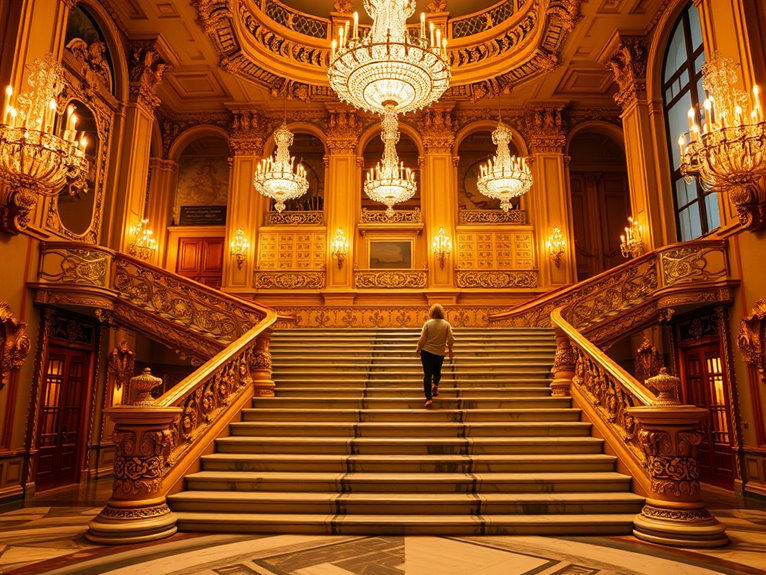
The Grand Staircase, or "L'Escalier d'Honneur," stands as the crowning architectural achievement within Paris's legendary Palais Garnier. Designed by Charles Garnier and revealed in 1875, this monumental marble staircase represents the epitome of Second Empire opulence, featuring an intricate blend of multicolored marble, ornate bronze fixtures, and gleaming gold leaf accents that create an almost otherworldly ascending pathway to the opera house's grand foyer.
Beyond its practical function, the Golden Staircase serves as a theatrical space in itself, deliberately designed to showcase the social spectacle of 19th-century Parisian high society. The thirty-meter-high ceiling, adorned with magnificent frescoes, and the strategically placed mirrors create an atmosphere where opera-goers could see and be seen, making the act of ascending the stairs as much a performance as the productions staged in the opera house itself.
Quick Facts:
- Best visiting hours: 10:00 AM – 5:00 PM (less crowded on weekday mornings)
- Entry cost: €14 for adults (included in general opera house tour)
- Photography: Allowed without flash; tripods require special permission
- Accessibility: Elevator available for those with mobility issues
- Best lighting conditions: Late morning when natural light streams through windows
- Tour duration: 15-20 minutes for staircase area alone
The Architectural Marvel
The staircase spans an impressive width of 30 meters and features dual flights that diverge and reconverge, creating a dramatic symmetrical design. The balustrades, crafted from rare onyx marble and topped with bronze handrails, guide visitors upward through what many consider the world's most beautiful ceremonial staircase. Insider tip: Look for the hidden architect's signature carved into the marble near the bottom right of the first landing.
The Artistic Elements
The ceiling paintings by Isidore Pils depict scenes from mythology and allegories of music, while the surrounding statuary represents various aspects of the arts. The 128 balusters supporting the handrails are each individually carved, no two exactly alike. Lesser-known fact: The marble used in construction comes from quarries in seven different countries, chosen specifically for their unique coloring and veining patterns.
Pro Tips:
For the best photographs, arrive early in the morning when tour groups are minimal and natural light creates dramatic shadows across the marble surfaces. Position yourself at the bottom of the stairs looking up for the most impressive architectural shots, or from the first landing for a perfect symmetrical view. During opera season, consider booking an evening performance to experience the staircase in its intended glory, illuminated by the original bronze and crystal light fixtures.
Practical Advice:
Book tickets for the opera house tour in advance through the official website to avoid queues. While the staircase is accessible throughout regular visiting hours, attending an evening performance offers a uniquely authentic experience of ascending the stairs in formal attire, just as 19th-century patrons did. Wear comfortable shoes with good grip, as the marble can be slippery, and bring a wide-angle lens if you're interested in photography to capture the full grandeur of the space.
